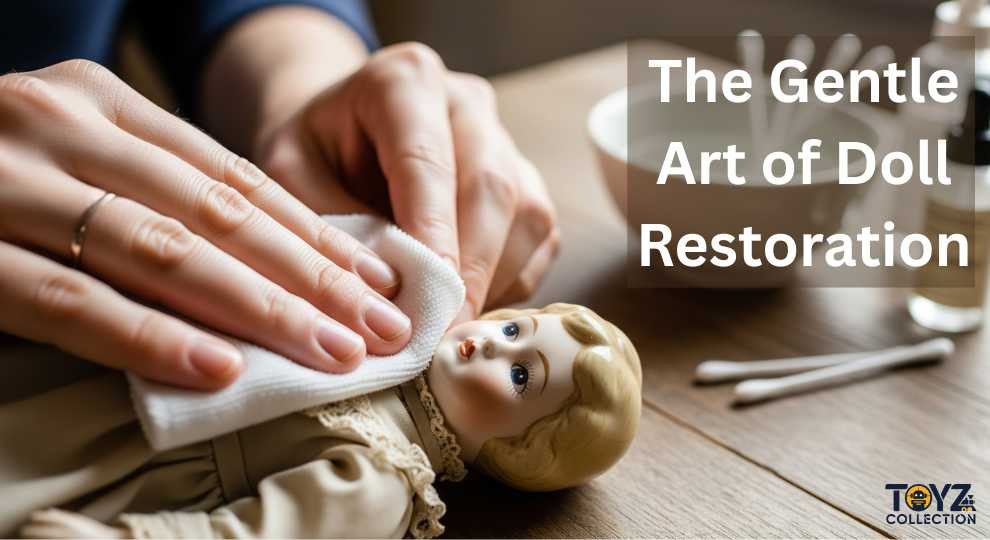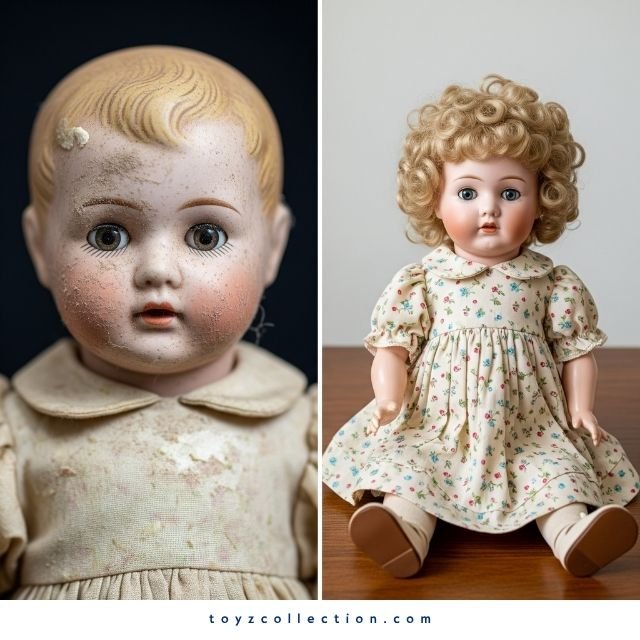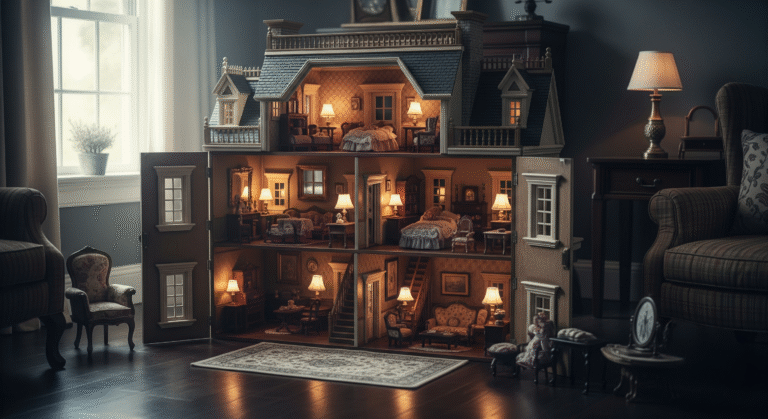How to clean vintage dolls without ruining them that’s the worry every collector faces. Over time, dust, stains, and even mold can settle into the doll’s face, clothes, and hair, making it look worn or forgotten. But harsh scrubbing or using the wrong product can cause permanent damage. That’s why you need a gentle, proven method to bring back your doll’s charm without losing its original beauty. You’ll discover how to clean delicate surfaces like porcelain faces, soften stiff doll hair, wash old cloth bodies without shrinking them, and safely treat stains or mold spots on vintage doll clothes. Each step is designed for real collectors like you, who value both looks and history. With care and the right approach, your vintage doll can shine again clean, safe, and beautifully restored.
How to Clean and Restore Old Vintage Dolls?
Step-by-Step Cleaning Guide for Vintage Dolls
Dusting Comes First
Start with dry dusting. Take a soft paintbrush or a clean, lint-free cloth. Gently brush off dust from the doll’s face, hands, legs, and clothes. Be slow older dolls can have cracked paint or worn fabric that breaks with rough touch. If the doll has curls or wigs, use a baby toothbrush to clean tiny spots without pulling hair out.
Gentle Washing
Next, prepare lukewarm water with a drop of baby shampoo or mild dish soap. Dip a soft sponge or cloth into the water. Gently rub areas where dirt sticks like fingers, feet, or behind the neck. Be careful near painted faces or glued joints. Don’t soak the whole doll unless you are sure it’s safe. Vinyl dolls can go in a light bath, but porcelain and cloth dolls should never be dunked fully.
Rinse Properly
Now take clean, lukewarm water. Wipe off all soap with a fresh cloth. Don’t leave any soap behind it may cause cracks or fading later. For dolls with tiny body parts, use cotton swabs for better reach.
Air Dry with Care
Pat the doll dry with a soft towel. Never rub. Place the doll on a clean towel in a shaded room. Keep it out of direct sun it fades color and weakens fabric. Let it dry fully. Even small water left inside can grow mold or ruin glue seams.
Special Cleaning Tips by Doll Type
Cleaning Vinyl Dolls
Vinyl dolls are easier to clean. Use a Magic Eraser for strong marks, but test first on the back of the leg or arm. Don’t press hard on painted areas; paint can rub off. Some collectors say baking soda and dish soap mix works great for sticky spots. Apply gently and rinse off well.
Example:
If your 1980s Barbie has crayon marks on her leg, try a Magic Eraser on the stain. But avoid her face paint it can vanish fast.

Cleaning Cloth Dolls
Cloth dolls need water but not much. Hand wash them with baby detergent in a basin. Soak only if stuffing won’t break. Then roll the doll in a towel to remove water. Lay flat to dry or hang by a foot with a clothespin in shade.
Example:
If you own a Raggedy Ann doll from your grandma’s shelf, give her a fabric bath, just her, not the whole toy chest.
Cleaning Porcelain Dolls
Porcelain dolls are delicate. Don’t dip them in water. Use a soft cloth dipped in soapy water to clean the porcelain parts only. The body, if cloth, needs to be cleaned apart. Wipe slowly and dry right away.
Example:
Your Victorian-style porcelain doll with a cloth torso? Wipe her face with a wet cloth, and clean her body separately, no shortcuts.
Cleaning Doll Hair
Hair on dolls can be tricky. Use baby shampoo and cool water. Work slowly through the strands. For tangled hair, use a wide-tooth comb or your fingers. Rinse and dry with a towel. Let the hair air dry no dryers, no heat.
Example:
A 1970s Sasha doll with tangled rooted hair? Use baby shampoo and comb while the hair is wet. Wrap in tissue paper once dry to keep the shape.
How to Remove Stains and Clean Vintage Dolls

For tough stains like marker, glue, or mold, use small tricks:
– Use baking soda paste for plastic stains
– A hairdryer on low can help loosen glue residue
– For ink, try acne cream with benzoyl peroxide, but test first
Never use bleach, nail polish remover, or strong alcohol. These can melt paint, plastic, or ruin the doll’s smell and feel.
Example:
If your doll has ink on her cheek, apply a tiny bit of acne cream and let it sit in daylight for a few hours. Wipe off with a clean cloth repeat as needed.
Important Tips Before You Start
Test First
Always test your cleaning method on a hidden spot. Behind the leg, under a dress, or under the wig these spots won’t show damage if anything goes wrong.
Take Your Time
Cleaning takes time. One part at a time. Let each part dry before moving on. Hurrying may cause stains, tears, or cracks.
Say No to Harsh Chemicals
No bleach, no alcohol, no rough scrubbers. Even if the doll looks tough, the materials might not be. Always pick mild soap and gentle tools.
Ask for Help If Unsure
If you have a rare or expensive doll, talk to a professional doll restorer. They know what works for specific materials and how to repair tiny damage without loss.
How to Clean Vintage Dolls’ Hair Safely
Cleaning hair on vintage dolls takes care and the right steps. If not done gently, hair may fall out or turn sticky. To clean vintage dolls’ hair, start by brushing it with a soft, wide-tooth comb to remove dust and tangles. Then mix a little baby shampoo in cool water. Dip a cloth or cotton ball in it, not the whole doll, and slowly clean the strands.
Rinse with a clean, damp cloth. Never soak the doll’s head, as water might damage glue or cause mold inside. After cleaning, pat the hair dry with a towel. Let it air dry flat or in soft curlers to keep the shape. Avoid hair dryers or heat tools they melt synthetic hair.
Collector Tip: Dolls like 1980s Barbie or Sasha with rooted hair clean best with shampoo and low brushing. For mohair or real hair, use cold water and no shampoo just gentle fabric softener if needed.
How to Clean Vintage Dolls Clothes Without Ruin
Antique doll clothes are often handmade, stitched from silk, linen, or cotton. These fabrics fade or shrink fast if cleaned the wrong way. To clean vintage dolls’ clothes, first check for weak seams, rusted buttons, or dry rot. Then hand wash using baby shampoo or a mild detergent in cold water.
Never rub or wring. Swish the fabric in water gently, then rinse in cold water. To dry, lay the clothes flat on a white towel. Hanging can stretch them out.

Here’s a quick guide for fabric-safe care:
| Fabric Type | Cleaning Method | Drying Tip |
| Cotton | Cold water wash | Lay flat to dry |
| Linen | Mild soap soak | Press in towel |
| Silk | Spot clean only | Air dry in shade |
| Velvet | No wash; brush dry | Store with tissue paper |
Collector Tip: If clothes have lace or trim, use mesh bags to protect them during wash. If stained, treat spots with a paste of baking soda and water before washing.
How to Clean Porcelain Dolls’ Hair and Clothes
Porcelain dolls need extra care. Their faces are painted and crack easily. To clean vintage dolls made of porcelain, use a soft cloth with baby soap for the head and limbs. Don’t let water touch the painted areas for long.
Hair should be cleaned gently. Most porcelain dolls have wigs glued to the scalp. Use a cloth dampened with diluted shampoo to wipe hair. Do not comb unless it’s safe mohair or synthetic fiber.
Clothes need hand washing only if the color doesn’t bleed. Before washing, test a small part by dabbing it with a wet cotton swab. If color runs, don’t wash.
Cleaning Table for Porcelain Dolls:
| Part | Method | Avoid |
| Porcelain Face | Damp cloth + mild soap | Scrubbing, soaking |
| Wig Hair | Cloth + baby shampoo | Pulling, brushing while wet |
| Fabric Dress | Cold hand wash | Hot water, machine wash |
Collector Tip: Store cleaned porcelain dolls in acid-free boxes with tissue paper between hair and face to avoid marks.
How to Clean Yellowed Doll Clothes Gently
Yellowing is common in vintage clothes due to age, air, and storage. To clean vintage dolls’ yellowed clothes, soak them in a mixture of cold water and gentle oxygen-based bleach (never chlorine). Add white vinegar if you want to break down odor or mold.
Let it soak for 1–2 hours. Don’t scrub. After that, rinse well and press flat between clean towels to dry. Avoid direct sunlight. You may need to repeat the process if yellowing is deep.
Collector Tip: For doll dresses with embroidery or painted details, never bleach. Use lemon juice and salt paste on the stained spot and leave it under indoor light for an hour before washing.
Perk Doll Clothes Cleaner: Is It Safe for Vintage Use?
Some collectors ask if Perk Doll Clothes Cleaner is safe for old fabrics. This product is known for treating dirt and mild discoloration to clean vintage dolls. While many modern doll owners use it, vintage collectors should test first. It may be too strong for fragile fabrics from the 1950s or earlier.
To try it safely:
- Test on a small inside seam
- Apply with a Q-tip
- Watch for fading or fabric thinning
If no change happens in 24 hours, you may proceed. But hand washing with mild detergent still remains the safest option for most vintage garments.
Collector Tip: Perk is useful for removing musty smells from stored doll clothes, especially for 1980s or 1990s play dolls. For antique cloth, stick to tried and tested baby detergent or museum-approved cleaners.
After cleaning, proper storage also matters. If your dolls live in a display setting, see how to manage a dusty vintage dollhouse to keep their surroundings as spotless as they are.
Frequently Asked Questions (FAQ)
How do I clean an old doll?
Start with a damp microfiber cloth and clean in circles. For tough stains, gently use a Magic Eraser. Avoid scrubbing painted areas too hard.
What to do with really old dolls?
Donate to thrift stores, charities, or antique shops near you. They may sell or display them. Ask first, they often welcome vintage pieces.
Why do old dolls get sticky?
Over time, plastic breaks down, causing a sticky film. This happens on rubbery limbs or soft heads. Clean with mild soap or baking soda paste.
How did you take care of a doll?
Use a laundry bag if machine washing. Pat dry with a towel and air dry in shade to protect materials and color.
How do I remove odors from vintage dolls?
Place the doll in a sealed bag with baking soda or dryer sheets for a few days to absorb smells.
Is it safe to wash doll clothes in a washing machine?
Only if they’re sturdy and modern. Always place them in a mesh bag and use cold water with gentle cycle.
How can I tell if a doll is valuable?
Check for maker’s marks, dates, and original clothing. Rarity, brand, and condition all affect value, research or ask a collector.

